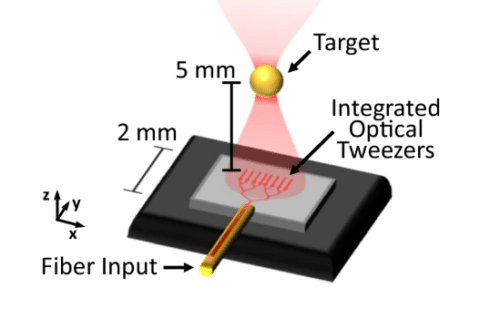Researchers develop a chip-based optical device that captures and manipulates biological cells for disease research.

The research team from Massachusetts Institute of Technology (MIT), US have created a palm-sized, chip-based ‘tractor beam’ that uses focused light to capture and manipulate cells without physical contact. The device, inspired by “Star Wars” technology, could offer biologists and clinicians a compact tool to study DNA, classify cells, and explore disease mechanisms. The target audience spans from biophysicists and cellular biologists to research labs and medical institutions eager for precise, sterile methods to manipulate cells in sensitive environments. Using silicon-photonics technology, the device’s light beam is emitted from a chip, enabling particle manipulation at distances up to millimetres away from its surface, maintaining the sterility crucial for biological samples.
Traditional optical tweezers, which require bulky microscope setups, have generally struggled to capture cells at greater distances from the chip surface. By contrast, this new chip, developed by an MIT team led by Jelena Notaros, professor (electrical engineering), MIT solves this problem with an integrated optical phased array that steers the beam millimetres from the chip surface, allowing biologists to work with samples enclosed in protective glass cover slips. “This work opens up new possibilities for chip-based optical tweezers by enabling trapping and tweezing of cells at much larger distances than previously demonstrated,” Notaros explains, noting the broad range of biological applications this device could unlock.
The phased array chip contains microscopic antennas that emit a focused beam, achieving an impressive feat: the ability to trap particles over millimetre-scale distances. Previous devices were limited to particles positioned very close to the chip, risking contamination. With new design, biologists and researchers focused on cell-based studies could avoid direct contact between cells and the chip surface, preserving both the cells and device integrity for reuse.
This innovation could benefit researchers in fields like biophysics and cellular biology. For instance, cancer researchers and those studying immune response could more effectively investigate complex biological interactions, such as how cells respond to various drugs. Initial tests of the device showed it successfully captured and manipulated tiny polystyrene spheres, followed by tests with cancer cells. “There were many unique challenges that came up in the process of applying silicon photonics to biophysics,” says Tal Sneh, Ph D student & lead author, MIT.
As the research team refines their technology, they envision enhancing its focal flexibility to handle different types of cells and particles. Future versions may feature multiple trap sites, expanding its potential applications in more complex biological systems.








